北师大版(2019)选择性必修第二册Unit 6 The Media Topic Talk说课课件(共21张PPT)
文档属性
| 名称 | 北师大版(2019)选择性必修第二册Unit 6 The Media Topic Talk说课课件(共21张PPT) | 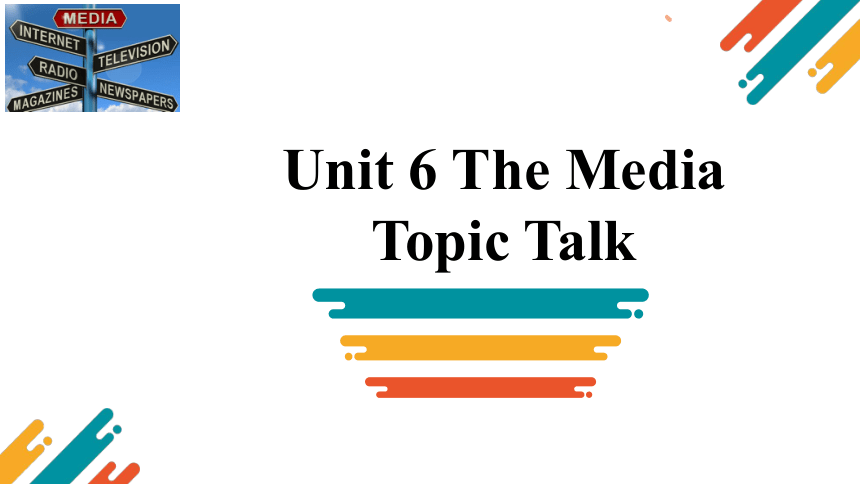 | |
| 格式 | pptx | ||
| 文件大小 | 6.5MB | ||
| 资源类型 | 教案 | ||
| 版本资源 | 北师大版(2019) | ||
| 科目 | 英语 | ||
| 更新时间 | 2022-11-10 18:04:34 | ||
图片预览

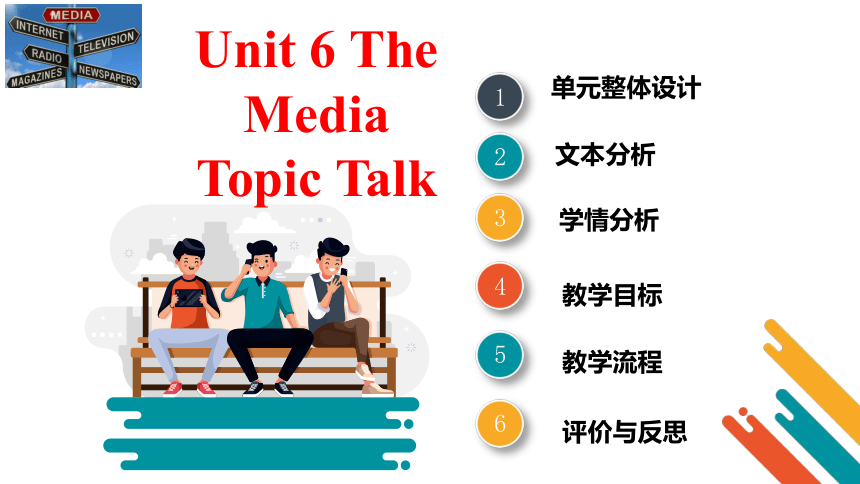
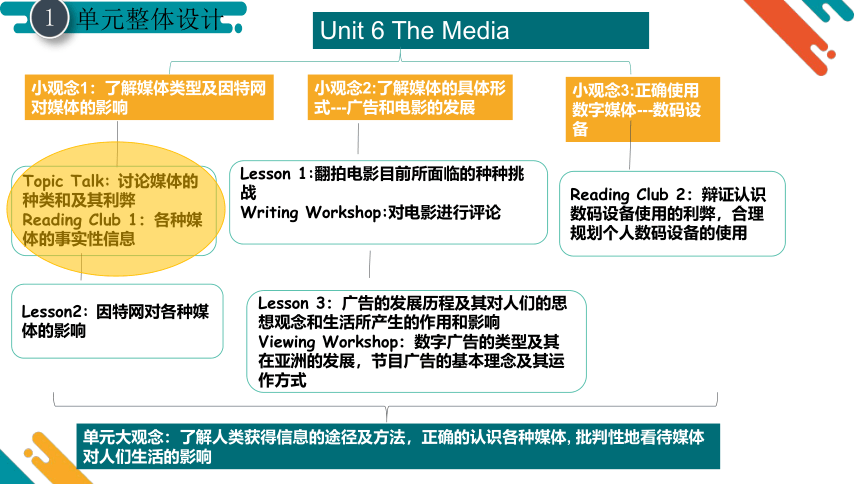
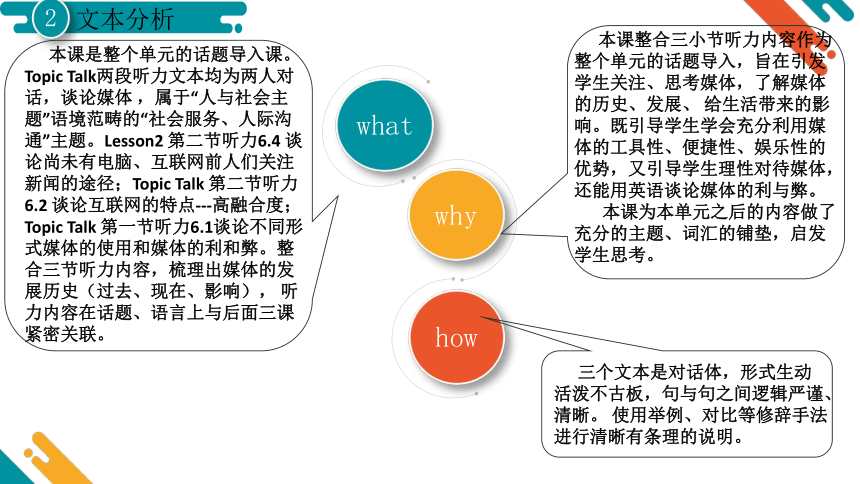
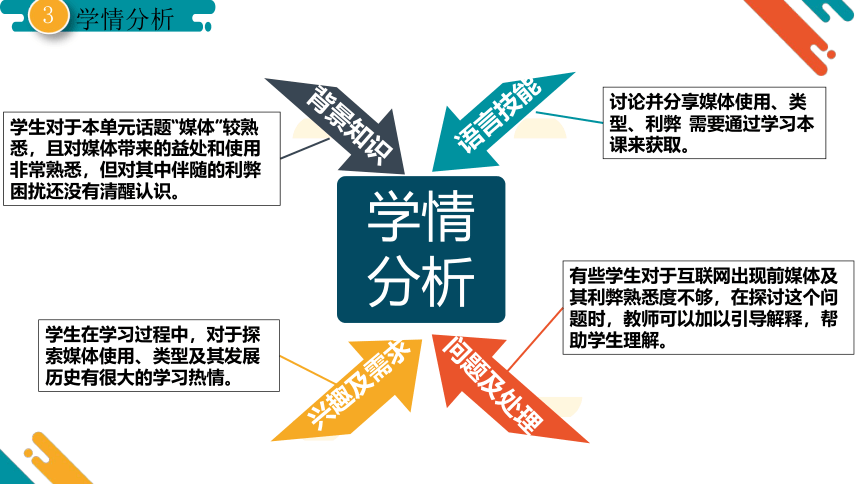
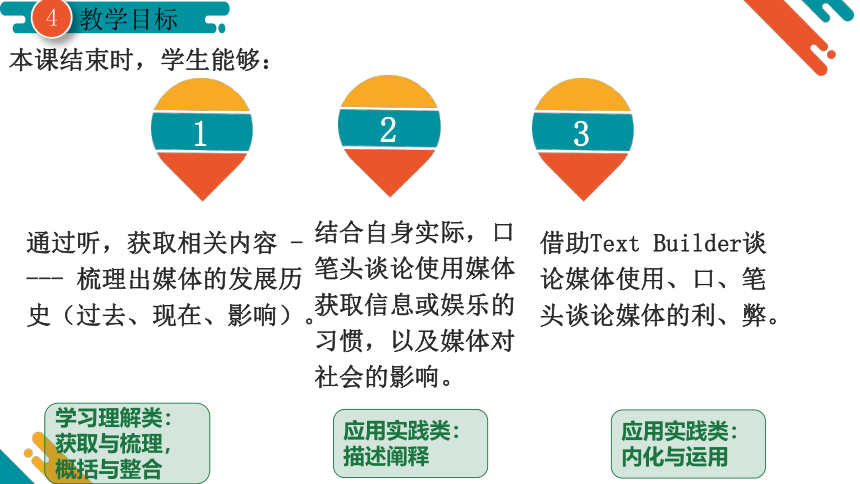


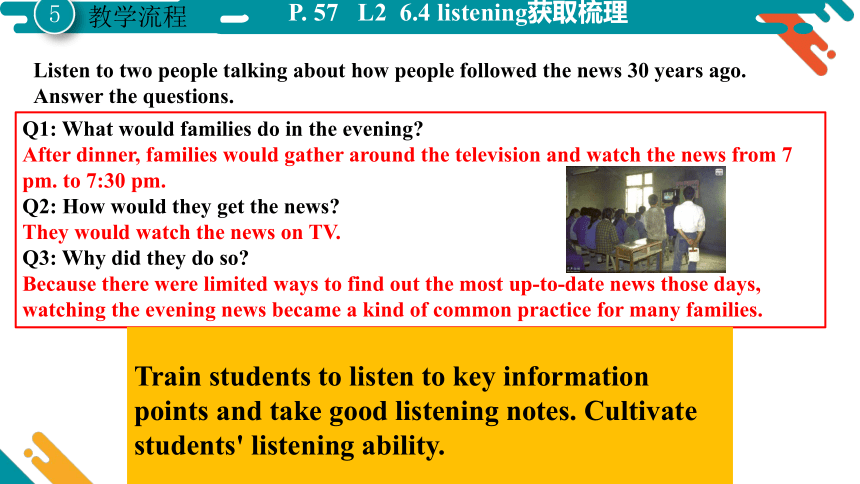
文档简介
(共21张PPT)
Unit 6 The Media
Topic Talk
1
2
3
4
5
6
单元整体设计
文本分析
学情分析
教学目标
教学流程
评价与反思
Unit 6 The Media
Topic Talk
单元整体设计
1
2
1
3
1
Unit 6 The Media
小观念1:了解媒体类型及因特网对媒体的影响
小观念3:正确使用数字媒体---数码设备
小观念2:了解媒体的具体形式---广告和电影的发展
单元大观念:了解人类获得信息的途径及方法,正确的认识各种媒体, 批判性地看待媒体对人们生活的影响
Topic Talk: 讨论媒体的种类和及其利弊
Reading Club 1:各种媒体的事实性信息
Lesson 1:翻拍电影目前所面临的种种挑战
Writing Workshop:对电影进行评论
Reading Club 2:辩证认识数码设备使用的利弊,合理规划个人数码设备的使用
Lesson2: 因特网对各种媒体的影响
Lesson 3:广告的发展历程及其对人们的思想观念和生活所产生的作用和影响
Viewing Workshop:数字广告的类型及其在亚洲的发展,节目广告的基本理念及其运作方式
文本分析
1
2
1
1
3
2
why
4
what
why
how
本课是整个单元的话题导入课。 Topic Talk两段听力文本均为两人对话,谈论媒体 ,属于“人与社会主题”语境范畴的“社会服务、人际沟通”主题。Lesson2 第二节听力6.4 谈论尚未有电脑、互联网前人们关注新闻的途径;Topic Talk 第二节听力6.2 谈论互联网的特点---高融合度;Topic Talk 第一节听力6.1谈论不同形式媒体的使用和媒体的利和弊。整合三节听力内容,梳理出媒体的发展历史(过去、现在、影响), 听力内容在话题、语言上与后面三课紧密关联。
本课整合三小节听力内容作为整个单元的话题导入,旨在引发学生关注、思考媒体,了解媒体的历史、发展、 给生活带来的影响。既引导学生学会充分利用媒体的工具性、便捷性、娱乐性的优势,又引导学生理性对待媒体,还能用英语谈论媒体的利与弊。
本课为本单元之后的内容做了充分的主题、词汇的铺垫,启发学生思考。
三个文本是对话体,形式生动活泼不古板,句与句之间逻辑严谨、清晰。 使用举例、对比等修辞手法进行清晰有条理的说明。
语言技能
背景知识
学情分析
3
问题及处理
兴趣及需求
学情分析
学生对于本单元话题“媒体”较熟悉,且对媒体带来的益处和使用非常熟悉,但对其中伴随的利弊困扰还没有清醒认识。
学生在学习过程中,对于探索媒体使用、类型及其发展历史有很大的学习热情。
讨论并分享媒体使用、类型、利弊 需要通过学习本课来获取。
有些学生对于互联网出现前媒体及其利弊熟悉度不够,在探讨这个问题时,教师可以加以引导解释,帮助学生理解。
教学目标
通过听,获取相关内容 ---- 梳理出媒体的发展历史(过去、现在、影响)。
1
2
1
1
1
4
1
1
1
3
2
1
1
学习理解类:获取与梳理,概括与整合
应用实践类:描述阐释
应用实践类:内化与运用
结合自身实际,口笔头谈论使用媒体获取信息或娱乐的习惯,以及媒体对社会的影响。
借助Text Builder谈论媒体使用、口、笔头谈论媒体的利、弊。
本课结束时,学生能够:
01
02
03
04
Lead In
5
教学流程
Lead In the Topic
Listening
6.4+6.2+ 6.1
Group discussion
Homework
感知
注意
获取
梳理
内化
运用
迁移创新
Do you know how people 30 years ago got the news around the world
2
1
1
2
3
P. 57 L2 6.4 listening
Activate and Share
感知注意
interview with a senior person about how people followed the news 30 years ago.Please translate the following questions into English.
Q1:那时的人们晚上一家人会做些什么?
Q2:他们是如何获取新闻的?
Q3:他们为什么这么做?
Introduce the topic, stimulate the students to think, prepare for the listening activity.
Provide scaffolding for students to listen to key information and prepare them for listening.
5
教学流程
2
1
1
2
3
Listen to two people talking about how people followed the news 30 years ago. Answer the questions.
Q1: What would families do in the evening
After dinner, families would gather around the television and watch the news from 7 pm. to 7:30 pm.
Q2: How would they get the news
They would watch the news on TV.
Q3: Why did they do so
Because there were limited ways to find out the most up-to-date news those days, watching the evening news became a kind of common practice for many families.
P. 57 L2 6.4 listening获取梳理
Train students to listen to key information points and take good listening notes. Cultivate students' listening ability.
5
教学流程
2
1
1
2
3
Do you use the Internet often
What do you use it for
P. 51 Listening 6.2 感知注意
Activate and Share
Before people had computers and the Internet, they followed the news by gathering around the television and watching the same news from 7 PM to 7.30 PM
5
教学流程
Introduce the topic "the Internet", stimulate students' thinking and introduce listening 6.2
Answer the questions, filling the blanks.
1. What does Ben use the Internet for
Ben ___________________ to research things for school, _________
___________________________ by finding alternative opinions on the subject and even ______________ like watching Ping-Pong tournaments.
2. What type of media does Anna prefer to use
She prefers ____________________like newspapers, magazines and the radio.
3. What didn’t Anna know about the Internet
She didn’t know _________________________ on the Internet.
consults the Internet
to better
to do fun things
to use traditional media
she can find all the things
understand complicated issues
P. 51 Listening 6.2 获取梳理
5
教学流程
Fill in the blanks, improve students' listening ability and information sorting ability.
It's amazing that the Internet can provide so many different types of media.
P. 50 Listening 6.1 感知注意
Activate and Share
What kind of media do you use often
What do you use each one for
5
教学流程
Are there any possible advantages and disadvantages of using these various media Give examples and talk about it with your partner.
Introduce the topic "the media" to stimulate students' thinking and introduce listening 6.1
Students read through 6.1 quickly to understand sentence frames and vocabulary. Listen and complete the sentences in the blanks. Answer the question:
Listening P. 50 Listening 6.1 获取梳理整合
5
教学流程
I use so much media on a daily basis.
I _____________ in the mornings; and in the afternoons, I ______________. In the evenings, I _______________________________.
The radio helps give people _________________ ____
___________. On the other hand, the Internet gives us so much ___________.
One advantage is that _________________ ___________ hence it can be difficult to _____________. ________________ is really challenging.
Media allows us to _______________________________ and it can also ______________________________, so
we can __________________________________________.
Choices of Information
Functions of media
Disadvantages
Advantages
Train students to listen to key information points and take good listening notes. Cultivate students' listening ability and thinking quality.
Listening P. 50 Listening 6.1 获取梳理整合
The Media
Choices of Information
Functions of media
Disadvantages
Advantages
Text Builder
1) Does Mark have a favorite type of media?
He doesn’t really have a favorite type.
2)How does he use media
He uses so much media on a daily basis, choosing different media at different time for different purposes.
3)How does Mark think of media
There are both advantages and disadvantages to the media, in his opinion
Answer the question:
Answer the quesitons 获取整合
5
教学流程
Train students to listen to key information points and take good listening notes. Cultivate students' listening ability and thinking quality.
Use the Text Builder to talk about what kind of media that you often use to get information or entertain yourself.
运用内化
5
教学流程
Analyze and express personal opinions based on themes and content.
2
1
1
2
3
5
教学流程
[问卷调查] 班级问卷调查:
1.最使用喜欢的媒体类型。
2.科学、正确利用媒体的方法。
Speaking and writing
Homework
运用内化
Create opportunities for students to internalize their knowledge of the language and the theme.
1
2
1
1
2
3
6
教学特色和评价与反思
本课先从全Lesson2 第二节听力6.4 入手,了解互联网产生前,人们获取新闻信息的方式 。 结合Topic Talk 6.2 & 6.1教学,通过反复听力,并回答基于听力内容的相关问题,加深学生对媒体的发展历史(过去、现在、影响)的理解。然后让学生写下学生写下对各种媒体使用和认识,运用本课所学语言知识和表达。
1
2
1
1
2
3
6
本课是一堂听力课,听力内容对于现阶段的高二学生还好理解。在学生听力之前,教师应对出现的一些难词解读一下,帮助学生理解。 给同学们留作家庭作业,若时间充足的话,则课堂中先讨论一下,课后让学生完成或润色形成书面作业。
教学特色和评价与反思
M
E
D
I
A
Thank You
Unit 6 The Media
Topic Talk
1
2
3
4
5
6
单元整体设计
文本分析
学情分析
教学目标
教学流程
评价与反思
Unit 6 The Media
Topic Talk
单元整体设计
1
2
1
3
1
Unit 6 The Media
小观念1:了解媒体类型及因特网对媒体的影响
小观念3:正确使用数字媒体---数码设备
小观念2:了解媒体的具体形式---广告和电影的发展
单元大观念:了解人类获得信息的途径及方法,正确的认识各种媒体, 批判性地看待媒体对人们生活的影响
Topic Talk: 讨论媒体的种类和及其利弊
Reading Club 1:各种媒体的事实性信息
Lesson 1:翻拍电影目前所面临的种种挑战
Writing Workshop:对电影进行评论
Reading Club 2:辩证认识数码设备使用的利弊,合理规划个人数码设备的使用
Lesson2: 因特网对各种媒体的影响
Lesson 3:广告的发展历程及其对人们的思想观念和生活所产生的作用和影响
Viewing Workshop:数字广告的类型及其在亚洲的发展,节目广告的基本理念及其运作方式
文本分析
1
2
1
1
3
2
why
4
what
why
how
本课是整个单元的话题导入课。 Topic Talk两段听力文本均为两人对话,谈论媒体 ,属于“人与社会主题”语境范畴的“社会服务、人际沟通”主题。Lesson2 第二节听力6.4 谈论尚未有电脑、互联网前人们关注新闻的途径;Topic Talk 第二节听力6.2 谈论互联网的特点---高融合度;Topic Talk 第一节听力6.1谈论不同形式媒体的使用和媒体的利和弊。整合三节听力内容,梳理出媒体的发展历史(过去、现在、影响), 听力内容在话题、语言上与后面三课紧密关联。
本课整合三小节听力内容作为整个单元的话题导入,旨在引发学生关注、思考媒体,了解媒体的历史、发展、 给生活带来的影响。既引导学生学会充分利用媒体的工具性、便捷性、娱乐性的优势,又引导学生理性对待媒体,还能用英语谈论媒体的利与弊。
本课为本单元之后的内容做了充分的主题、词汇的铺垫,启发学生思考。
三个文本是对话体,形式生动活泼不古板,句与句之间逻辑严谨、清晰。 使用举例、对比等修辞手法进行清晰有条理的说明。
语言技能
背景知识
学情分析
3
问题及处理
兴趣及需求
学情分析
学生对于本单元话题“媒体”较熟悉,且对媒体带来的益处和使用非常熟悉,但对其中伴随的利弊困扰还没有清醒认识。
学生在学习过程中,对于探索媒体使用、类型及其发展历史有很大的学习热情。
讨论并分享媒体使用、类型、利弊 需要通过学习本课来获取。
有些学生对于互联网出现前媒体及其利弊熟悉度不够,在探讨这个问题时,教师可以加以引导解释,帮助学生理解。
教学目标
通过听,获取相关内容 ---- 梳理出媒体的发展历史(过去、现在、影响)。
1
2
1
1
1
4
1
1
1
3
2
1
1
学习理解类:获取与梳理,概括与整合
应用实践类:描述阐释
应用实践类:内化与运用
结合自身实际,口笔头谈论使用媒体获取信息或娱乐的习惯,以及媒体对社会的影响。
借助Text Builder谈论媒体使用、口、笔头谈论媒体的利、弊。
本课结束时,学生能够:
01
02
03
04
Lead In
5
教学流程
Lead In the Topic
Listening
6.4+6.2+ 6.1
Group discussion
Homework
感知
注意
获取
梳理
内化
运用
迁移创新
Do you know how people 30 years ago got the news around the world
2
1
1
2
3
P. 57 L2 6.4 listening
Activate and Share
感知注意
interview with a senior person about how people followed the news 30 years ago.Please translate the following questions into English.
Q1:那时的人们晚上一家人会做些什么?
Q2:他们是如何获取新闻的?
Q3:他们为什么这么做?
Introduce the topic, stimulate the students to think, prepare for the listening activity.
Provide scaffolding for students to listen to key information and prepare them for listening.
5
教学流程
2
1
1
2
3
Listen to two people talking about how people followed the news 30 years ago. Answer the questions.
Q1: What would families do in the evening
After dinner, families would gather around the television and watch the news from 7 pm. to 7:30 pm.
Q2: How would they get the news
They would watch the news on TV.
Q3: Why did they do so
Because there were limited ways to find out the most up-to-date news those days, watching the evening news became a kind of common practice for many families.
P. 57 L2 6.4 listening获取梳理
Train students to listen to key information points and take good listening notes. Cultivate students' listening ability.
5
教学流程
2
1
1
2
3
Do you use the Internet often
What do you use it for
P. 51 Listening 6.2 感知注意
Activate and Share
Before people had computers and the Internet, they followed the news by gathering around the television and watching the same news from 7 PM to 7.30 PM
5
教学流程
Introduce the topic "the Internet", stimulate students' thinking and introduce listening 6.2
Answer the questions, filling the blanks.
1. What does Ben use the Internet for
Ben ___________________ to research things for school, _________
___________________________ by finding alternative opinions on the subject and even ______________ like watching Ping-Pong tournaments.
2. What type of media does Anna prefer to use
She prefers ____________________like newspapers, magazines and the radio.
3. What didn’t Anna know about the Internet
She didn’t know _________________________ on the Internet.
consults the Internet
to better
to do fun things
to use traditional media
she can find all the things
understand complicated issues
P. 51 Listening 6.2 获取梳理
5
教学流程
Fill in the blanks, improve students' listening ability and information sorting ability.
It's amazing that the Internet can provide so many different types of media.
P. 50 Listening 6.1 感知注意
Activate and Share
What kind of media do you use often
What do you use each one for
5
教学流程
Are there any possible advantages and disadvantages of using these various media Give examples and talk about it with your partner.
Introduce the topic "the media" to stimulate students' thinking and introduce listening 6.1
Students read through 6.1 quickly to understand sentence frames and vocabulary. Listen and complete the sentences in the blanks. Answer the question:
Listening P. 50 Listening 6.1 获取梳理整合
5
教学流程
I use so much media on a daily basis.
I _____________ in the mornings; and in the afternoons, I ______________. In the evenings, I _______________________________.
The radio helps give people _________________ ____
___________. On the other hand, the Internet gives us so much ___________.
One advantage is that _________________ ___________ hence it can be difficult to _____________. ________________ is really challenging.
Media allows us to _______________________________ and it can also ______________________________, so
we can __________________________________________.
Choices of Information
Functions of media
Disadvantages
Advantages
Train students to listen to key information points and take good listening notes. Cultivate students' listening ability and thinking quality.
Listening P. 50 Listening 6.1 获取梳理整合
The Media
Choices of Information
Functions of media
Disadvantages
Advantages
Text Builder
1) Does Mark have a favorite type of media?
He doesn’t really have a favorite type.
2)How does he use media
He uses so much media on a daily basis, choosing different media at different time for different purposes.
3)How does Mark think of media
There are both advantages and disadvantages to the media, in his opinion
Answer the question:
Answer the quesitons 获取整合
5
教学流程
Train students to listen to key information points and take good listening notes. Cultivate students' listening ability and thinking quality.
Use the Text Builder to talk about what kind of media that you often use to get information or entertain yourself.
运用内化
5
教学流程
Analyze and express personal opinions based on themes and content.
2
1
1
2
3
5
教学流程
[问卷调查] 班级问卷调查:
1.最使用喜欢的媒体类型。
2.科学、正确利用媒体的方法。
Speaking and writing
Homework
运用内化
Create opportunities for students to internalize their knowledge of the language and the theme.
1
2
1
1
2
3
6
教学特色和评价与反思
本课先从全Lesson2 第二节听力6.4 入手,了解互联网产生前,人们获取新闻信息的方式 。 结合Topic Talk 6.2 & 6.1教学,通过反复听力,并回答基于听力内容的相关问题,加深学生对媒体的发展历史(过去、现在、影响)的理解。然后让学生写下学生写下对各种媒体使用和认识,运用本课所学语言知识和表达。
1
2
1
1
2
3
6
本课是一堂听力课,听力内容对于现阶段的高二学生还好理解。在学生听力之前,教师应对出现的一些难词解读一下,帮助学生理解。 给同学们留作家庭作业,若时间充足的话,则课堂中先讨论一下,课后让学生完成或润色形成书面作业。
教学特色和评价与反思
M
E
D
I
A
Thank You
同课章节目录
- Unit 4 Humour
- Lesson 1 What’s So Funny?
- Lesson 2 Why Do We Need Humour?
- Lesson 3 My Favourite Comedian
- Unit 5 Education
- Lesson 1 Enlightening a Mind
- Lesson 2 The Objectives of Education
- Lesson 3 Understanding
- Unit 6 The Media
- Lesson 1 From Page to Screen
- Lesson 2 Questions about Media
- Lesson 3 The Advertising Game
